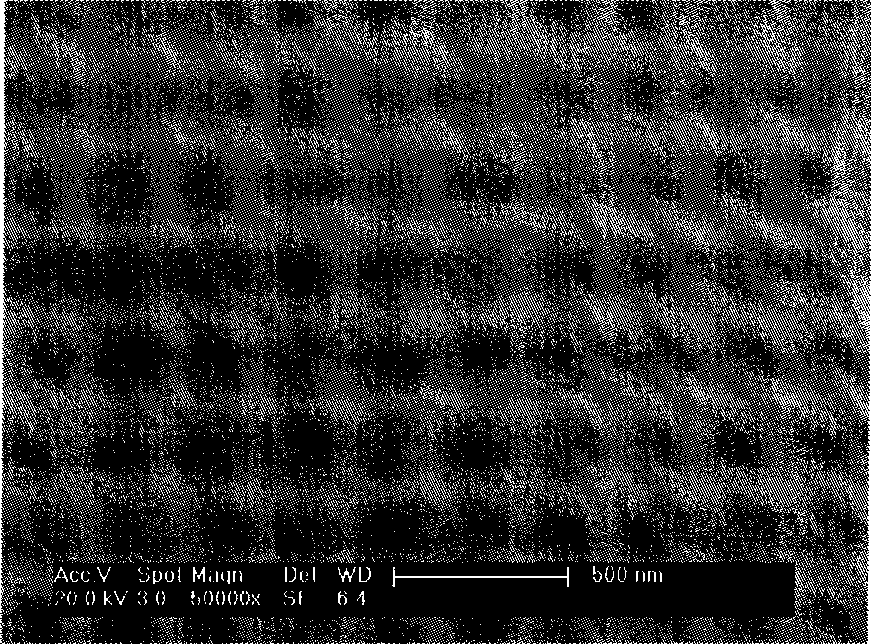Method for supporting nano titanic oxide on surface of carrier material
A technology of nano-titanium dioxide and carrier materials, applied in chemical instruments and methods, nanotechnology, nanotechnology, etc., can solve the problems of nanoparticle erosion and difficult control, and achieve the best performance effect
- Summary
- Abstract
- Description
- Claims
- Application Information
AI Technical Summary
Problems solved by technology
Method used
Image
Examples
Embodiment 1
[0022](1) Carrier material preparation. Take glass as the carrier as needed, wash with water to remove the dust on the surface, and then soak in NaOH-Na 2 CO 3 Washing in the mixed solution, NaOH and Na in the mixed solution 2 CO 3 The mass concentration is 5% to wash away the surface oil, and finally wash with deionized water and dry for later use.
[0023] (2) Nano-TiO 2 Preparation of ethanol suspension. Take 0.5g nanometer TiO 2 The powder was mixed with 200ml of absolute ethanol, and ball milled at 450r / min for 15h in a ball mill to obtain nano-TiO with a concentration of 2.5g / L and uniform dispersion. 2 ethanol suspension.
[0024] (3) Adhesive coating. Immerse the treated glass carrier material in a silica sol solution with a concentration of 25wt%, and take it out after fully immersing; after the coating is completely dry, immerse it in a silica sol solution with a concentration of 5wt%, and take it out after fully immersing. After the coating is completely dr...
Embodiment 2
[0027] (1) Carrier material preparation. Take foamed nickel as the carrier as needed, wash with water to remove the dust on the surface, and then soak in NaOH-Na 2 CO 3 Washing in the mixed solution, NaOH and Na in the mixed solution 2 CO 3 The mass concentration of the silica sol is 5% to wash off the surface oil, and then soaked in a 5% HCl solution for 10 minutes to improve the wettability with the silica sol. Finally, it is washed with deionized water and dried for later use.
[0028] (2) Nano-TiO 2 Preparation of ethanol suspension. Take 0.5g nanometer TiO 2 The powder was mixed with 500ml of absolute ethanol, and ball milled at 500r / min for 12h in a ball mill to obtain nano-TiO with a concentration of 1g / L and uniform dispersion. 2 ethanol suspension.
[0029] (3) Adhesive coating. The treated foamed nickel carrier material is immersed in a silica sol solution with a concentration of 10 wt%, and taken out after fully immersing. After the coating is completely dr...
Embodiment 3
[0032] (1) Carrier material preparation. Take porous ceramics as the carrier as needed, wash with water to remove the dust on the surface, and then soak in NaOH-Na 2 CO 3 Washing in the mixed solution, NaOH and Na in the mixed solution 2 CO 3 The mass concentration is 5% to wash away the surface oil, and finally wash with deionized water and dry for later use.
[0033] (2) Nano-TiO 2 Preparation of ethanol suspension. Take 0.1g nanometer TiO 2 The powder was mixed with 200ml of absolute ethanol, and ball milled at 400r / min for 8h in a ball mill to obtain nano-TiO with a concentration of 0.5g / L and uniform dispersion. 2 ethanol suspension.
[0034] (3) Adhesive coating. Immerse the treated porous ceramic carrier material in a silica sol solution with a concentration of 5wt%, and take it out after fully soaking; after the coating is completely dry, immerse it in a silica sol solution with a concentration of 25wt%, and take it out after fully soaking. After the coating i...
PUM
 Login to View More
Login to View More Abstract
Description
Claims
Application Information
 Login to View More
Login to View More - Generate Ideas
- Intellectual Property
- Life Sciences
- Materials
- Tech Scout
- Unparalleled Data Quality
- Higher Quality Content
- 60% Fewer Hallucinations
Browse by: Latest US Patents, China's latest patents, Technical Efficacy Thesaurus, Application Domain, Technology Topic, Popular Technical Reports.
© 2025 PatSnap. All rights reserved.Legal|Privacy policy|Modern Slavery Act Transparency Statement|Sitemap|About US| Contact US: help@patsnap.com


